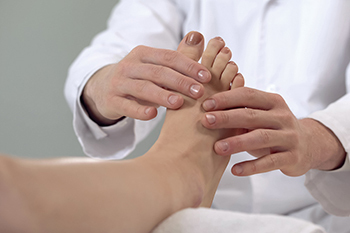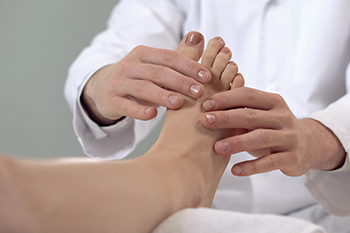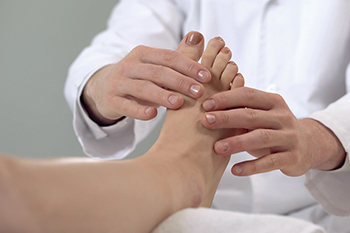September 2022
Facts About Rheumatoid Arthritis

Rheumatoid arthritis (RA) is a progressive auto-immune disease that causes inflammation, swelling, and pain in the joints of the foot, ankle, and toes. Symptoms include stiffness in the joints, especially when first waking up or after sitting for long periods. People with rheumatoid arthritis typically experience flare ups of pain, when their symptoms worsen. These may be caused by stress, overactivity, or changes in medication. With rheumatoid arthritis, the body’s immune system mistakenly attacks the synovium, which is a membrane that lines the joints. As a result, the synovial cells grow and the membrane thickens, in turn causing the pain and inflammation. Untreated RA can cause damage to the cartilage, tissue that keeps the bones from touching each other. People at high risk of developing rheumatoid arthritis include those who are over 60, female, obese, and who smoke. Genetics also can be a risk factor. Blood tests and imaging tests can help determine whether you have rheumatoid arthritis. For testing, diagnosis, and treatment options, please consult a podiatrist.
Because RA affects more than just your joints, including the joints in your feet and ankles, it is important to seek early diagnosis from your podiatrist if you feel like the pain in your feet might be caused by RA. For more information, contact Dr. Anna Petrov of Family Foot & Ankle Care. Our doctor will assist you with all of your podiatric concerns.
What Is Rheumatoid Arthritis?
Rheumatoid Arthritis (RA) is an autoimmune disorder in which the body’s own immune system attacks the membranes surrounding the joints. Inflammation of the lining and eventually the destruction of the joint’s cartilage and bone occur, causing severe pain and immobility.
Rheumatoid Arthritis of the Feet
Although RA usually attacks multiple bones and joints throughout the entire body, almost 90 percent of cases result in pain in the foot or ankle area.
Symptoms
- Swelling and pain in the feet
- Stiffness in the feet
- Pain on the ball or sole of feet
- Joint shift and deformation
Diagnosis
Quick diagnosis of RA in the feet is important so that the podiatrist can treat the area effectively. Your doctor will ask you about your medical history, occupation, and lifestyle to determine the origin of the condition. Rheumatoid Factor tests help to determine if someone is affected by the disease.
If you have any questions please feel free to contact one of our offices located in Wheeling and Chicago, IL . We offer the newest diagnostic and treatment technologies for all your foot and ankle needs.
Diabetes and Heel Fissures

Cracked heels, or heel fissures, are cracks or splits in the skin on the soles of the feet, often going through to the inner layers of skin. They can be painful when pressure is applied to the skin while standing, and they can bleed. This condition generally comes from dry skin. Loss of nerve supply to the sweat glands in the feet can happen to diabetics, because they tend to have drier skin than others. Heel fissures are common in the general population, but those with diabetes can have more serious consequences if they do not deal with cracked heels effectively. Diabetics can also suffer from neuropathy, causing loss of feeling in the feet. With the loss of sensation, patients with diabetes can have fissures that bleed and can possibly become infected and ulcerated without knowing it. If you are a diabetic, make sure to visually inspect your feet regularly. If you have cracked heels or some other foot problem, it is important for you to see a podiatrist for prompt treatment.
Diabetic foot care is important in preventing foot ailments such as ulcers. If you are suffering from diabetes or have any other concerns about your feet, contact Dr. Anna Petrov from Family Foot & Ankle Care. Our doctor can provide the care you need to keep you pain-free and on your feet.
Diabetic Foot Care
Diabetes affects millions of people every year. The condition can damage blood vessels in many parts of the body, especially the feet. Because of this, taking care of your feet is essential if you have diabetes, and having a podiatrist help monitor your foot health is highly recommended.
The Importance of Caring for Your Feet
- Routinely inspect your feet for bruises or sores.
- Wear socks that fit your feet comfortably.
- Wear comfortable shoes that provide adequate support.
Patients with diabetes should have their doctor monitor their blood levels, as blood sugar levels play such a huge role in diabetic care. Monitoring these levels on a regular basis is highly advised.
It is always best to inform your healthcare professional of any concerns you may have regarding your feet, especially for diabetic patients. Early treatment and routine foot examinations are keys to maintaining proper health, especially because severe complications can arise if proper treatment is not applied.
If you have any questions please feel free to contact one of our offices located in Wheeling and Chicago, IL . We offer the newest diagnostic and treatment technologies for all your foot and ankle needs.
Obesity and Foot Swelling

Having swollen feet is certainly not a pleasant experience. Swelling in the feet occurs when bodily fluids become trapped or built-up in the tissues. As a result, the affected area can become significantly puffy, causing them to look markedly bigger than usual. Although swelling in the feet has a litany of different causes, obesity is one potential contributing factor to swollen feet. When an individual is obese, or overweight, they can sometimes experience reduced blood circulation, which then can make the feet become swollen. Additionally, since obese people carry more weight, they consequently exert more pressure on their feet and this can cause pain when walking. As a result, obese people may minimize their physical activity, which can make fluids become trapped in the feet. If you are an individual that struggles with obesity, please schedule an appointment with a podiatrist to discuss ways to mitigate your foot pain. In consultation with your podiatrist, you may discuss whether or not losing weight would help you reduce the problems that you are experiencing in your feet. Do not take any chances with the health of your feet–contact a podiatrist today.
Obesity has become very problematic at this point in time and can have extremely negative effects on the feet. If you’re an obese individual and are concerned about your feet, contact Dr. Anna Petrov from Family Foot & Ankle Care. Our doctor can provide the care you need to keep you pain-free and on your feet.
Obesity and Your Feet
Since your feet are what support your entire weight when standing, any additional weight can result in pain and swelling. Being overweight is one of the main contributors to foot complications.
Problems & Complications
Extra Weight – Even putting on just a few extra pounds could create serious complications for your feet. As your weight increases, your balance and body will shift, creating new stresses on your feet. This uneven weight distribution can cause pain, even while doing the simplest tasks, such as walking.
Diabetes – People who are overweight are at serious risk of developing type-2 diabetes, which has a drastic impact on the health of your feet. As you get older, your diabetes might worsen, which could lead to loss of feeling in your feet, sores, and bruises. You could also become more prone to various infections.
Plantar fasciitis – Pressure and stress that is placed on muscles, joints, and tendons can trigger plantar fasciitis, which is an inflammation of tissue that forms along the bottom of the foot.
If you have any questions please feel free to contact one of our offices located in Wheeling and Chicago, IL . We offer the newest diagnostic and treatment technologies for all your foot and ankle needs.
Cracked Heels in Runners

Running is a cherished form of exercise that many people across the country engage in every day. However, if a runner is not careful, they may be at risk of developing certain foot conditions. For example, running can increase the risk of developing cracked heels. Also known as heel fissures, cracked heels occur when the skin on the back of the heel becomes significantly dry and hardened. The skin may even crack due to the lack of moisture. Running can lead to cracked heels because as an individual is running, they are repeatedly hitting their heels on hard surfaces. This pounding of the heel on the ground can lead to cracked heels. Although cracked heels may not always be a serious condition in runners, they can be unsightly and uncomfortable. If you are a runner, you may protect yourself from developing this condition by removing dead skin cells from your feet with a pumice stone. You might also choose to apply a heavy moisturizer to the heels to keep them from cracking. Contact a podiatrist for more tips and tricks about preventing cracked heels in runners.
Cracked heels are unsightly and can cause further damage to your shoes and feet. If you have any concerns, contact Dr. Anna Petrov from Family Foot & Ankle Care. Our doctor can provide the care you need to keep you pain-free and on your feet.
Cracked Heels
Cracked heels appear unappealing and can make it harder for you walk around in sandals. Aside from looking unpleasant, cracked heels can also tear stockings, socks, and wear out your shoes. There are several methods to help restore a cracked heel and prevent further damage.
How Do You Get Them?
Dry skin is the number one culprit in creating cracked heels. Many athletes, walkers, joggers, and even swimmers suffer from cracked heels. Age and skin oil production play a role to getting cracked heels as well.
Promote Healing
Over the counter medicines can help, especially for those that need instant relief or who suffer from chronic dry feet.
Wear Socks – Wearing socks with medicated creams helps lock in moisture.
Moisturizers – Applying both day and night will help alleviate dryness which causes cracking.
Pumice Stones – These exfoliate and remove dead skin, which allows for smoother moisturizer application and better absorption into the skin.
Change in Diet
Eating healthy with a well-balanced diet will give the skin a fresh and radiant look. Your body responds to the kinds of food you ingest. Omega-3 fatty acids and zinc supplements can also revitalize skin tissue.
Most importantly, seek professional help if unsure how to proceed in treating cracked heels. A podiatrist will help you with any questions or information needed.
If you have any questions, please feel free to contact one of our offices located in Wheeling and Chicago, IL . We offer the newest diagnostic and treatment technologies for all your foot care needs.








